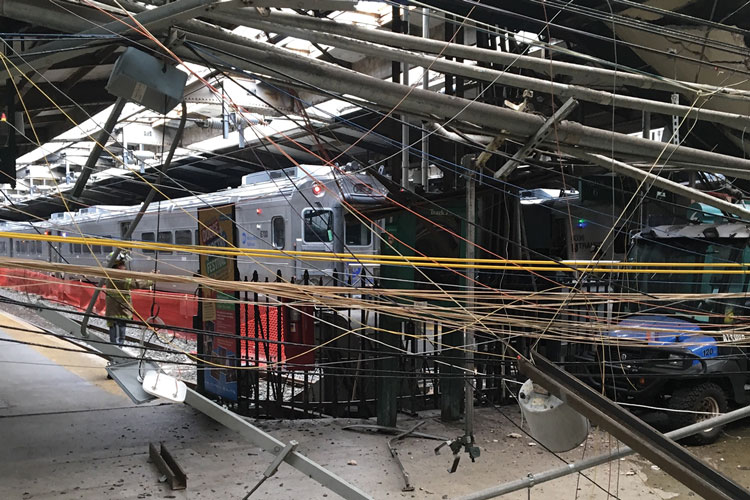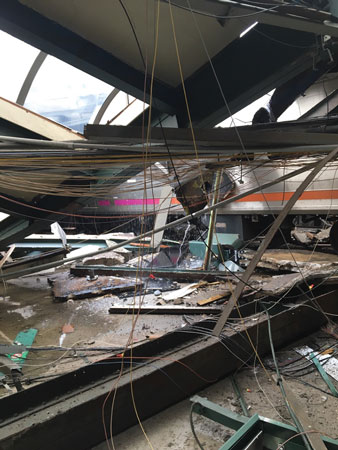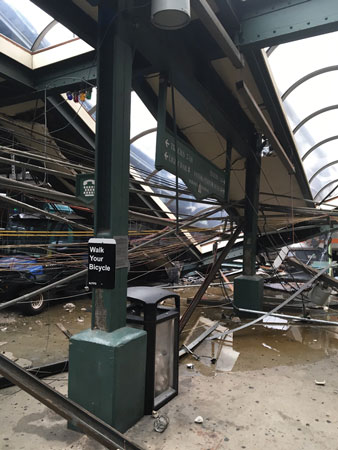
By BRIAN CRIMMINS
On Thursday, September 29, 2016, at 0847 hours, a commuter train crashed into the New Jersey Transit terminal in Hoboken, traveling at more than double the allowable speed limit. The train derailed by careening past the end of the tracks, onto a passenger walkway, and ultimately crashing into the wall of the New Jersey Transit waiting area. When this occurred, approximately 355 people were in the train station.
Hoboken (NJ) Fire Department (HFD) headquarters received a fire alarm activation call for the train station. The alarm company reported that numerous fire alarm locations activated; calls for 911 soon followed. With thousands of commuters passing through the train station every day, any rush-hour emergency can turn into a large-scale incident. A large-scale emergency can immediately turn tragic.
Hoboken Terminal is a target hazard; the city of Hoboken, according to the Federal Emergency Management Agency, is critical infrastructure. Located across the Hudson River from midtown Manhattan, Hoboken is a densely populated urban waterfront community with more than 50,000 residents living in just one square mile. Many residents commute to New York City by means of the Hoboken Terminal, a facility that houses stations for commuter trains, light rail trains, PATH subway trains, buses, water ferries, and taxis – all in the same area. Tens of thousands of commuters pass through Hoboken Terminal every day.
![(1) Access and egress routes were initially blocked by electrical wiring and debris. <i>[Photos courtesy of the Hoboken (NJ) Fire Department.]</i>](https://emberly.fireengineering.com/wp-content/uploads/2017/02/1702FE_WWLPic1.jpg) |
| (1) Access and egress routes were initially blocked by electrical wiring and debris. [Photos courtesy of the Hoboken (NJ) Fire Department.] |
Minutes after the crash, the HFD arrived on scene. As tour commander, I sized up the incident and established command. Several victims with apparent trauma symptoms were immediately visible outside the station. Dozens of other victims began exiting the building. I requested a second alarm. Fire dispatch informed me of the train crash and the structural damage to the building. I ordered the first-arriving ladder company to assess the damage and the first-arriving engine company to conduct patient triage and treatment. With only one ambulance on scene, emergency medical services (EMS) personnel were immediately overwhelmed.
More help arrived as the HFD rescue, heavy rescue, and rescue-trained engine companies positioned their apparatus. These members communicated with the ladder company regarding hazards and victims.
Second-alarm personnel arrived and began supporting rescue operations while also monitoring gas and radiation hazards. I decentralized command by assigning designations such as safety officer, accountability officer, rescue group supervisor, rescue group safety officer, logistics, search group, and so on. HFD Chief Anton Peskens, on hearing the radio reports, requested a firefighter recall, mutual-aid assistance, and an activation of the Urban Area Security Initiative Metro Urban Search and Rescue Strike Team (UASI MUST). Everyone went to work.
One of our immediate concerns was terrorism; it is always a consideration in major metropolitan areas, especially in target hazards like Hoboken Terminal. At the time of the incident, no one knew why the train had crashed, so we assumed the worst-case scenario. We requested New Jersey Transit Police to sweep for unknown hazards. Then, we began relocating all victims away from the terminal to help establish a perimeter.
 |
| (2) Two victims were trapped in the lead train car, which had derailed and crashed. |
Other concerns on scene were the number of victims, structural damage, and down electrical wires. More EMS resources arrived from across the state and formalized a command structure to triage, treat, and transport victims. Damage to the building was extensive. The roof had already partially collapsed, and it was sliding down farther. In response, firefighters shored up and stabilized unsafe structures. Down electric wires were everywhere, blocking access and egress routes. New Jersey Transit responded by shutting down all utilities, but it warned that residual power could potentially energize the area. The Port Authority of New York and New Jersey (NY/NJ) discontinued all subway service to minimize vibrations.
For about 49 minutes, firefighters, UASI MUST personnel, and police conducted rescue operations. Personnel cleared debris to create access and egress paths. Firefighters removed victims from the terminal and conducted primary and secondary searches. Two victims were trapped in the lead train car. Firefighters removed train windows for ventilation and egress. The HFD then rescued the first victim using a ground ladder. The HFD extricated the other victim from the train with saws and cutters/spreaders. Rescuers immobilized and packaged the patient while still aboard the train; they then handed the victim off to firefighters and EMS personnel standing outside by the train. All rescues were completed within the “golden hour” of survivability.
After about 49 minutes, all fire and rescue operations were completed. Federal investigators later stated that they were stunned at the expedience of the rescues. The operation was largely successful, although one victim tragically was killed by the crash. Firefighters and EMS personnel treated more than 100 victims, including those trapped in the lead train car.
With all rescues completed, New Jersey Transit ordered all emergency personnel to exit the building because of structural hazards. We conducted an accountability report to track all members. There were no reported firefighter or rescuer injuries.
Lessons Learned
The success of the rescue operation was largely the result of training. As members of UASI MUST, many Hoboken firefighters have extensive training in technical rescue. Members hone their skills in periodic company-level sessions and also participate in annual exercises with our MUST partners. This training is invaluable. Taxpayers received an excellent return on their investment in UASI. Simply stated, our rescue training saved lives.
Another major success was the mutual-aid response. Fire departments from Jersey City, North Hudson, Bayonne, and other cities from across northern New Jersey sent dozens of members to the train derailment. New Jersey Transit Police received support from the Hoboken Police Department, the Port Authority of NY/NJ Police Department, New Jersey State Police, and other law enforcement agencies. The mutual-aid response was immediate and critically important. Even the New Jersey Regional Fireboat Task Force and New York Police Department marine units responded to provide waterfront security and safe landing for medevac helicopters.
 |
| (3) The roof of the train station had collapsed prior to our arrival. |
Next, I witnessed excellent decision making by firefighters on scene. Officers asked for assistance when needed, split their crews when necessary, and called for equipment in anticipation of potential changes in conditions. Mutual-aid chiefs served as additional safety officers and division supervisors. Members were removed from hazard areas for not wearing the correct personal protective equipment. Finally, ongoing face-to-face communication mitigated potential interagency radio problems.
Last, patient triage served as a tremendous learning experience. The HFD has had minimal EMS training; we are not emergency medical technicians. Only on occasion do we respond to support ambulance crews. At the train derailment, we learned how difficult patient triage is. Several patients identified as “walking wounded” lost consciousness before our eyes. Thankfully, experienced officers from the Hoboken Volunteer Ambulance Corps and other agencies assisted and directed our firefighters, ensuring that victims received appropriate care.
Missed opportunities are always present at a large-scale incident.
- I regret not wearing a command vest and not issuing vests to supervisory personnel on scene. Although the command structure was clear to HFD firefighters, mutual-aid and law enforcement personnel would have benefited from identifying supervisors by their vests.
- We failed to stretch hoselines at the incident. Although there was no fire or an apparent threat of fire, the situation could have easily changed for the worse. This was an unfortunate oversight that taught us an important lesson.
- Radio communications were spotty. Aside from upgrading our equipment, there was little we could do on scene to prevent missed transmissions. However, as stated above, face-to-face communication was very helpful.
Postincident Debriefing
Days later, I conducted a postincident critique and after-action review for the HFD. Fire officers and firefighters shared their experiences. Some members requested additional rescue and transit training. I thanked everyone for a job well done. I also wish to publicly thank all outside agencies for their valuable assistance.
In addition, I acknowledged that members placed their personal safety at risk to rescue trapped victims. I nominated members for valor awards to recognize the courageous, life-saving actions made in the face of danger. I reminded members of the hazards of post-traumatic stress disorder and encouraged firefighters to call our crisis hotline for professional counseling, if needed. Firefighters performed valiantly to mitigate severe hazards. I am proud to be working with a group of such dedicated professionals.
BRIAN CRIMMINS is a battalion chief and tour commander with the Hoboken (NJ) Fire Department. He has a BA from Boston College and an MPA from John Jay College.
FDNY Rescue 3 Ops at Train Derailment
CT Train Derailment and Mass Casualty Response
DC Metro Train Accident Poses Access Challenges
Fire Engineering Archives

